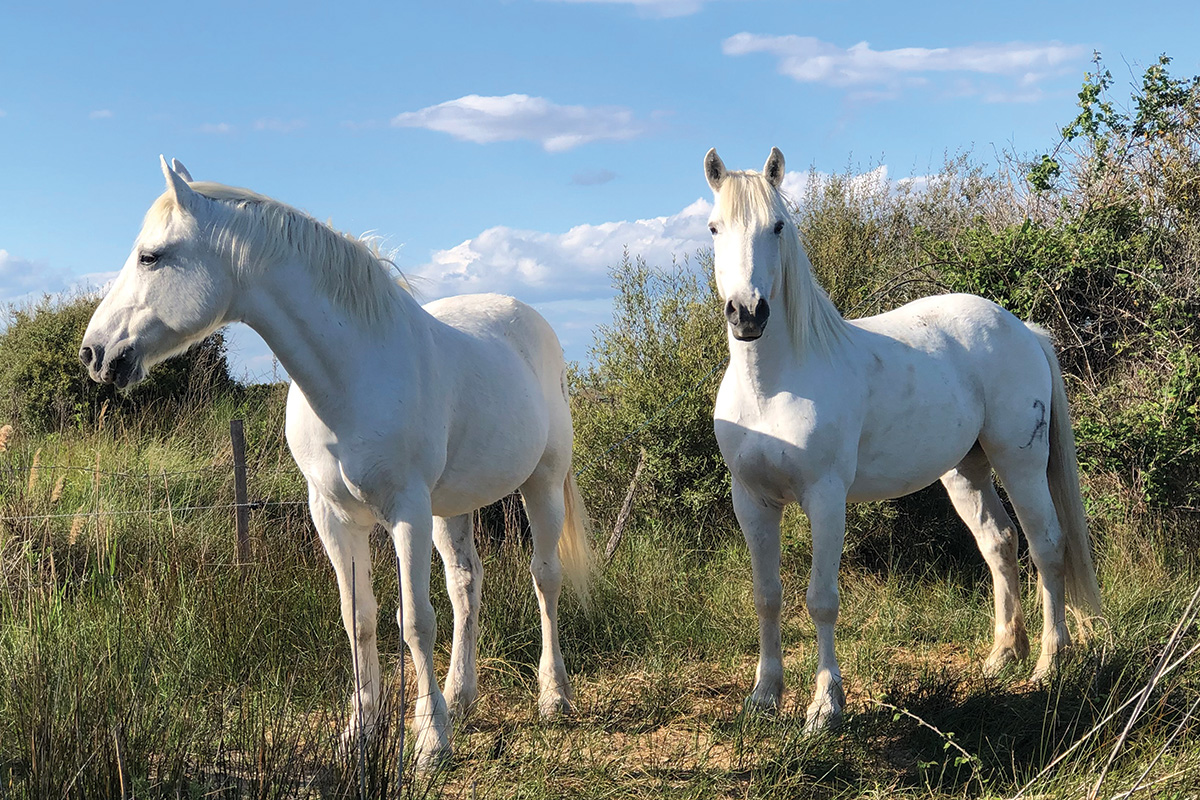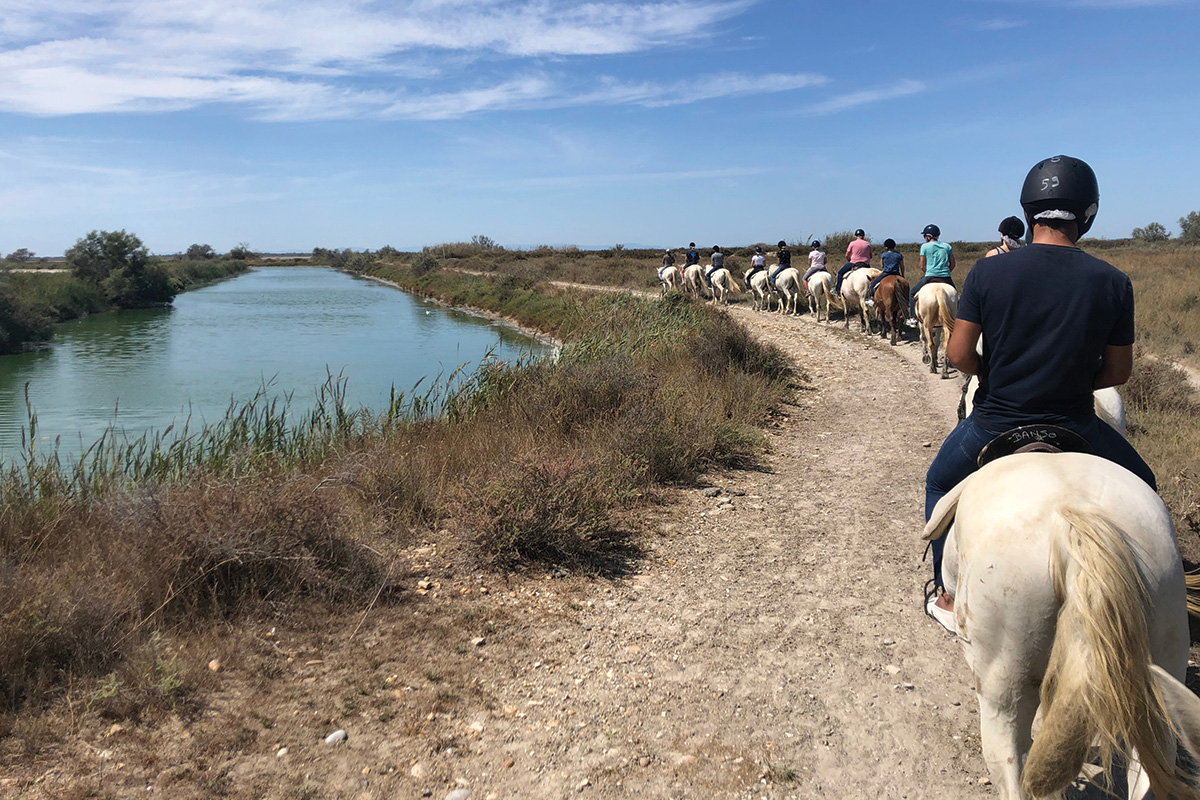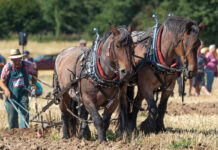
The Camargue Natural Park stretches over a triangular area of almost 580 square miles in the South of France; especially for horse enthusiasts, this is a magical location to visit.
Camargue horses have come to symbolize the wild spirit of the region. Believed to be descendants of prehistoric equines that lived in France during the Paleolithic period 17,000 years ago, the white horses of the Camargue are one of the oldest breeds in the world.
Exposed to torrid heat and insects in the summer and the bitter cold of the notorious mistral wind in the winter, these tough little horses mirror the extremes of the local climate and are best known as the companion of French cattle herders who uphold the region’s wild-west reputation.
Arriving on the Ranch
Spread across the soggy grasslands are a plethora of ranches set up for vacationers and the raising of horses and cattle. Riding a Camargue horse is almost a rite of passage for visitors to this part of France, and there are signs everywhere advertising trails for novices, children, and experienced riders alike.
Manade St. George is off the beaten track. In this out-of-the-way corner of France, the flat terrain and wide horizons stretch as far as the eye can see. To arrive at the farm, I need to drive down a long, straight road for miles.
When I finally get there, it is raining heavily, and a tall woman in an ankle-length oilskin coat opens the gate for me. The staff are tacking up a string of gray horses. Robin, the guide, greets me with his strong handshake.
I am given a helmet and introduced to my horse for the day—Icarus, a 10-year-old Camargue gelding.
The Ride
We depart the farm and ride single-file alongside fields of fierce-looking black bulls and misty lagoons. The stillness of the marshlands is disturbed only by our soft hoofprints in the soil and the occasional comment in French from the guide.
Even though the Camargue region has a reputation as a rugged, wild place, it’s easy to see that it is actually a fragile environment. When the rain stops, yellow irises are reflected like a mirage in the now limpid waters.

Situated on the crossroads of Africa, Europe and the Mediterranean, the Camargue represents an important stopover for the hundreds of thousands of migrating birds that pass through each year. Reed beds provide home to a wide range of avian varieties, and the seasonal flooding of these fields of bullrushes creates feeding grounds for birds. The still waters also attract a less welcome visitor: the mosquito. I was told to visit in the early spring to avoid them, but that didn’t really work.
Mosquitoes swarm us as we ride, and I regret not spraying myself down with repellent, naively thinking that the rain would keep them at bay. The French gentleman riding behind me chuckles, “I will ride beside you; I think that way they will prefer to bite you over me.”
We ride through the marshes at a smart pace—a lot of canters and some trotting. Icarus is jittery due to a group of horses that have tagged along with our group. His walk is fast, and he likes to be near the front.
On arrival at the Little Rhône river, our guide enthusiastically explains that we are taking the horses on a boat to the other side.
He isn’t kidding.
We dismount and lead our horses onto the back of a cable ferry called the Bac du Sauvage, or Sauvage Ferry, which takes us across to the Petit Camargue, the oldest nature reserve in the region. It’s the first time I’ve ever caught a ferry with a horse.
On the other side of the river, we mount up and quietly ride off. Soon we are on a private estate that the guides have exclusive access to. We ride along the windswept farmland, passing lagoons and salt pans with herds of Camargue horses grazing quietly.
Galloping on the Water
Cranes and other birds are omnipresent. We canter alongside a verdant green lagoon. Robin indicates for the horses to slow. As our horses drop to a walk, he motions toward the canal, where we see two beavers casually swimming past.
Robin moves ahead of the group to open a sand-blasted wooden gate. We take turns passing through, and just like that, we find ourselves on the open beach.
The light around us is instantly transformed into a pearly glow. Our vicinity to the sea and the low horizons creates a mirror-like effect on the water. The sun is out, and it beats down on us relentlessly. The water is teeming with life. Local plants like sea lavender and glasswort flourish here.
We splash through the shallow water, surrounded by ethereal white herons and squawking pink flamingos. Since this is private land, we can enjoy a faster pace without the risk of meeting any tourists.
Icarus is a star, smoothly changing gears as he accelerates from canter to gallop. We pound down the beach with salt water in our eyes and joy in our hearts.
Arriving at a point where the lagoons meet the sea, he eases back to a walk without any objection. It is one of the few occasions on the ride that he does not resist a slower pace. Damp and badly bitten, but too exhilarated to mind, we walk the horses back through sandy tracks and pine forests for a picnic lunch and much needed rest, complete with wine, cheese and meats.
We take a different route home using a network of country lanes and the occasional piece of road. The sky clears and the brilliant sunshine of May warms our backs while casting a sheen on the green fields around us.
As the light fades, frogs and crickets start their evening chorus, and we return to the stable.
A Place Like No Other
Riding horses is the ideal way to get around France’s Camargue Natural Park. While guided tours are also offered for people with absolutely no riding experience, my eight-hour adventure was suitable for fit riders (I walked like John Wayne for three days afterwards), and this type of ride will lead you into wilder landscapes that are totally untouched by human infrastructure.
The wild west of France needs to be seen to be believed. Riding and the Camargue really do go hand in hand. The region boasts incredible scenery, passionate people, food, wine, and so much more, but it was the unique equestrian culture that I found most fascinating.
This article about riding Camargue horses in France appeared in the January/February 2022 issue of Horse Illustrated magazine. Click here to subscribe!





